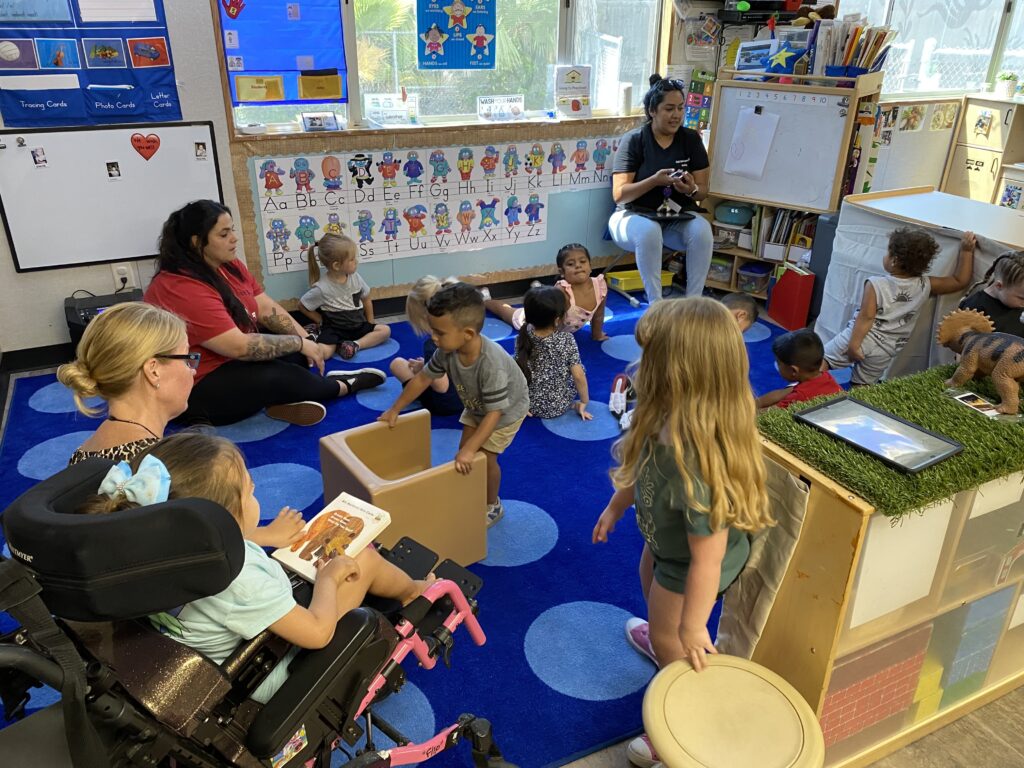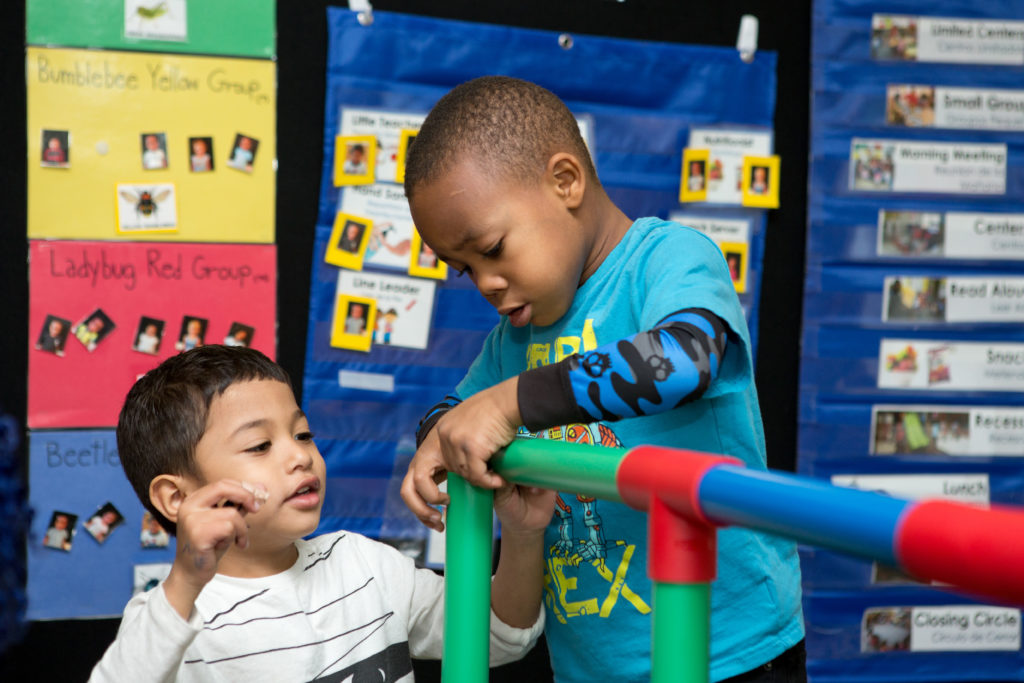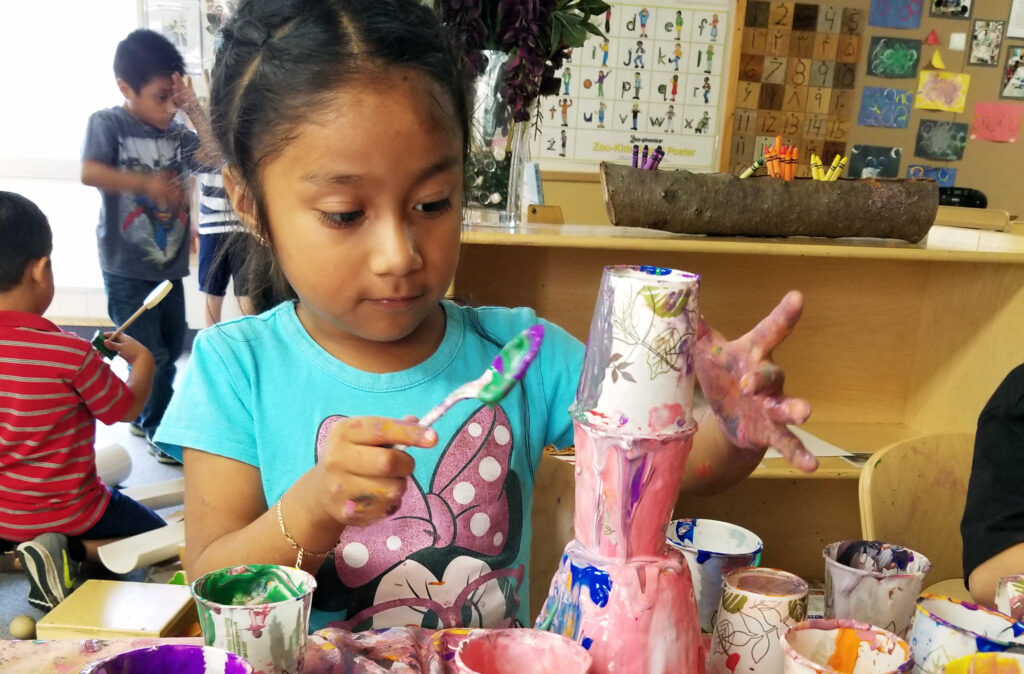
Marysville Joint Unified School District runs preschool for children with and without disabilities.
Courtesy of Marysville Joint Unified School District
Gov. Gavin Newsom invested millions into expanding preschool for children with disabilities. Now, he’s proposing to scale it back, to invest more in electric school buses.
The move is causing an uproar among leaders of county offices of education and school districts, and advocates for early education and special education.
“While I appreciate the governor’s dedication to climate change, as a special education administrator and somebody who’s been in the special education field, I think students with disabilities are more important than electric buses,” said Anthony Rebelo, director of the Trinity County Special Education Local Plan Area (SELPA) and chair of the Coalition for Adequate Funding for Special Education.
Two programs that aim to expand access to preschool for children with disabilities are proposed to be slashed in Newsom’s May revision of his budget proposal.
The first is an increase in the number of slots in state-subsidized preschool programs that are set aside for children with disabilities. Beginning in 2022, the state began to require these preschool programs to set aside at least 5% of their space to enroll children with disabilities. The percentage of space set aside was to increase to 7.5% in 2025-26, and to 10% in 2026-27. Facing a massive budget shortfall, Newsom is now proposing to cancel that increase and leave the number of slots for children with disabilities at 5%. This move would save the state $47.9 million in 2025-26 and $97.9 million ongoing, beginning in 2026–27.
The second program the governor plans to cut is the Inclusive Early Education Expansion Program, a program that was set to fund $250 million in grants to help school districts and county offices of education adapt facilities and playground equipment and train preschool teachers to meet the needs of children with disabilities. The state funded a first round of grants in 2020. School districts and county offices of education had applied in April for a second round of grants. The California Department of Education sent out award letters this week to some applicants specifying how much funding they can expect to receive.
During a May 16 hearing before the Senate Budget and Fiscal Review Subcommittee on Education, Alex Shoap, finance budget analyst from the California Department of Finance, made it clear Newsom is proposing “pulling back $250 million in currently unallocated Inclusive Early Education Expansion Program funding to instead support the electric school bus grant investment.”
H.D. Palmer, deputy director for external affairs for the Department of Finance, said the state Legislature had committed to putting $500 million toward electric school buses in 2024-25 and another $500 million in 2025-26. Newsom now aims to spend $395 million more on the buses in 2024-25, most of which would come from the Inclusive Early Education Expansion Program.
Palmer said spending more now on electric school buses would reduce the amount the state would have to pay in 2025-26 to $105 million.
In response to criticism of cuts to preschool for children with disabilities, Palmer pointed to the following comment from Newsom on May 10 when he announced his new budget proposals.
“You will ask me, I’m sure, in the Q and A, ‘Why this cut?’ I will undoubtedly say, ‘I prefer not to make this cut.’ These are programs, these are propositions that I’ve long advanced, many of them. These are things that I’ve supported. These are things we worked closely with the Legislature to advance. None of this is the kind of work you enjoy doing, but you’ve got to do it,” Newsom said.
School district and county leaders, as well as other preschool providers across the state expressed dismay that these programs would be cut at a time when preschool programs were just beginning to include more children with disabilities in their classrooms.
“It really is a breach of promise,” said Dave Gordon, Sacramento County superintendent of schools. “People have been planning for these services to go forward for several years. They’re ready to go. I have several people on my staff who are broken-hearted that this is not going to go forward, because they feel it’s been long delayed.”

Under the federal Individuals with Disabilities Education Act, children as young as 3 years old with disabilities must be provided special education. The U.S. Department of Education and the U.S. Department of Health and Human Services have stated that children with disabilities should have access to preschool and child care programs where they can participate alongside their peers without disabilities. California also made expanding access to inclusive preschool programs a goal in its Master Plan for Early Learning and Care, released in 2020.
“We’re woefully behind most states,” said Elizabeth Engelken, chair of the association SELPA Administrators of California. “We were relying on this … support to begin to shift the environment in schools to be more developmentally appropriate.”
Jolie Critchfield, director of child development for Marysville Joint Unified School District in Yuba County, said her district used funding from the Inclusive Early Education Expansion Program to train staff and completely revamp their preschool programs with new materials and playground equipment, like swings built for children with disabilities. The district also moved all “special day classrooms” alongside general preschool classrooms, so that children with disabilities are able to interact with other children on the playground and spend time in class with them as well.
She said the district planned to use future funding to increase coaching for teachers and to include more children with disabilities in general education preschool classrooms.
“It literally brings tears to your eyes, seeing the kids in the program with wheelchairs and scooters. Kids that you just would not think could be OK in a general education setting, because it would be too overwhelming, are going in there and doing so well,” Critchfield said. “I can’t believe we ever did it any differently.”
One mother, Stella Goodnough, said she is grateful her daughter was able to attend preschool in Marysville alongside children with disabilities.
“I was always afraid to approach special-needs children because I didn’t know what to say or do. Now I see my daughter make friends, especially a best friend, with a special-needs child,” said Goodnough. “She often talks about him at home, which creates opportunities to talk about how wonderful we all are with our differences.”

The Kings County Office of Education in the Central San Joaquin Valley used funding from the first round of grants to transform an old school building into an early learning center, with many services available for children with disabilities. The center, in Hanford, currently has one classroom where children with and without disabilities are taught together. The county office applied for another grant this year to open two more inclusion classrooms.
“Without this funding, our goals are once again relegated to a far-off future when we can’t ever guarantee when that might happen,” said Todd Barlow, Kings County superintendent of schools.
Several special education administrators said cutting the program would end up costing the state more in the future, because children who have had early education and services at a young age may not need as much intervention in later years.
“If we identify a student much earlier, get them in that school routine of what it’s like to have group instruction, they’re going to be much more prepared by the time they’re in kindergarten or TK,” Rebelo said. “This just feels like a huge step backwards.”
The budget proposal would cut about 200 children with disabilities from attending preschool at Kidango, a nonprofit organization that runs dozens of child care centers in the San Francisco Bay Area, according to the organization’s director, Scott Moore.
“This budget cut is not only harmful to children, but research shows it will result in higher special education costs in the future,” Moore said. “So it’s bad for kids and bad for the state budget.”
The state budget is still in negotiations until the Legislature passes a final bill in June.







